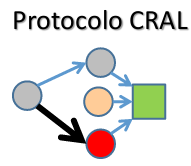CRAL: um algoritmo de roteamento baseado em centralidade e energia para Redes de Sensores Sem Fio
High throughput and energy are two important constraints of the Wireless Sensor Networks (WSNs). In this paper, we present the Centrality-based Routing Aware for L2Ns (CRAL)1 -Low Drop and Fast Delivery to mitigate these problems. The routing protocols are centrality-based and employ link quality estimators Expected Transmission Count (ETX) and Expected Transmission Time (ETT) to find best paths in wireless links. The suitable combinations of these techniques lead the algorithms to improve the literature results in delivery rate, energy consumption, and time to delivery data packets. CRAL does this by building routing trees with high throughput and maintains low energy consumption. The simulation results show that CRAL is more reliable, efficient in energy consumption, robust, and favoring data fusion than Centrality Tree (CT) and Shortest Paths Tree (SPT).
Please cite:
@article{santoscral,
title={CRAL: um algoritmo de roteamento baseado em centralidade e energia para Redes de Sensores Sem Fio},
author={Santos, Bruno P and Vieira, Luiz FM and Vieira, Marcos AM}
}
Bruno P. Santos, Luiz F. M. Vieira, Marcos A. M. Vieira.
Contatcs: {bruno.ps, lfvieira, mmvieira}@dcc.ufmg.br
Founding agency: CNPq.





Leave a comment